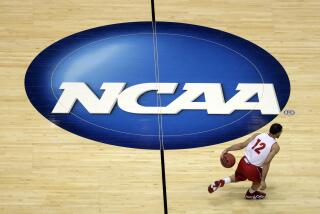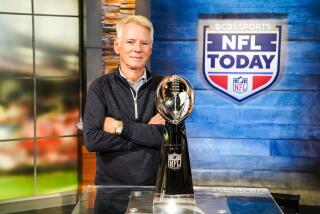How the Big Game Got So Big : SPORTS AND FREEDOM The Rise of Big-Time College Athletics<i> by Ronald A. Smith (Oxford University Press: $26.95; 320 pp., illustrated)</i>
- Share via
Ronald Smith begins his excellent history of intercollegiate sports with a brief account of an 1852 encounter. Harvard rowed against Yale on New Hampshire’s Lake Winnipesaukee because James Elkins of the Boston, Concord, and Montreal Railroad wanted them to. “If you will get up a regatta on the lake,” he told the students, “I will pay all the bills.” The commercialization of intercollegiate athletics began at that moment and has intensified to the point where the National Collegiate Athletic Assn. recently signed a TV contract for nearly $300 million. By the end of the 19th Century, coaches earned more than professors, and the revenues from football were a significant part of a university’s budget.
Although Smith tells the story of commercialization, his main theme is the shift in control of intercollegiate sports from the students to the faculty and administration and from them to the boards of trustees and the NCAA. In the 1840s, American students, stifled by the rarified intellectual atmosphere of the American college and restive under strict faculty control, emulated their English counterparts, formed sports teams and arranged contests. Their elders frowned. When Michigan challenged Cornell to a soccer game, President Andrew D. White disapproved: “I will not permit thirty men to travel four hundred miles merely to agitate a bag of wind.” When the contests began seriously to interfere with academic endeavors, which they did almost immediately, faculties and administrations tried to abolish sports or--at least--to control them. They failed.
But the students who successfully defended their freedom to play their games against the professors’ effort to control them were no match for the professional coaches whom they, rather than the faculty, had sought. The desire to win turned out to be stronger than the desire for autonomy. Unlike the British, who remained amateurs in every sense of the term, American students submitted to coaches whose know-how enhanced the prospects of victory in the Big Game. By the end of the century, coaches and athletic directors had the power to decide who played (no more graduate students) and under what conditions (regular practices and “a clean life”).
At various moments in his narrative, Smith suggests that the laissez-faire stage of student-run intercollegiate athletics was like the heyday of Gilded Age capitalism. Ruggedly individualistic capitalists gave up entrepreneurial independence for the benefits of corporate rationalism, and tudents exchanged the careless rapture of a challenge match for the greater efficiency of league schedules.
When the mania for victory at all costs led to the recruitment of the illiterate, the alteration of transcripts, savagery on the field and a variety of other familiar abuses, colleges and universities took the next step and reluctantly surrendered some of their authority to the NCAA. Nowhere is Smith’s narrative more lively than when he describes Theodore Roosevelt’s efforts to end the brutality of turn-of-the-century football and thus to blunt the abolitionist campaign of Harvard’s Charles William Eliot and Columbia’s Nicholas Murray Butler. Although the elite schools were reluctant to join the new national organization, they eventually accepted minimal controls rather than risk the demise of the whole system.
By 1905, asserts Smith, the pattern was set: “Huge crowds in enormous stadiums with large gate receipts, highly paid coaches in control of recruited athletes receiving handsome financial rewards, and the media telling the story and promoting the events were all in evidence.” This is an overstatement. It may be reasonable to argue that the electronic media have not made much of a difference in the structure of intercollegiate sports, but can one overlook the entry of women and minorities as important players and still maintain that the present system was in place in 1905?
Although Smith’s narrative makes it clear that truly amateur intercollegiate sports are even more unlikely today than they were in 1905, his prose is subdued. He is no Allison Danzig, sighing nostalgically, “Oh, how they played the game!” Smith has simply combed the archives and come up with the facts. If one reads between the lines, however, one occasionally discovers the Wisconsin farm boy and the intercollegiate athlete that Smith claims to have been. As Pascal remarked, the heart has its reasons, which reason cannot know.
More to Read
Go beyond the scoreboard
Get the latest on L.A.'s teams in the daily Sports Report newsletter.
You may occasionally receive promotional content from the Los Angeles Times.










